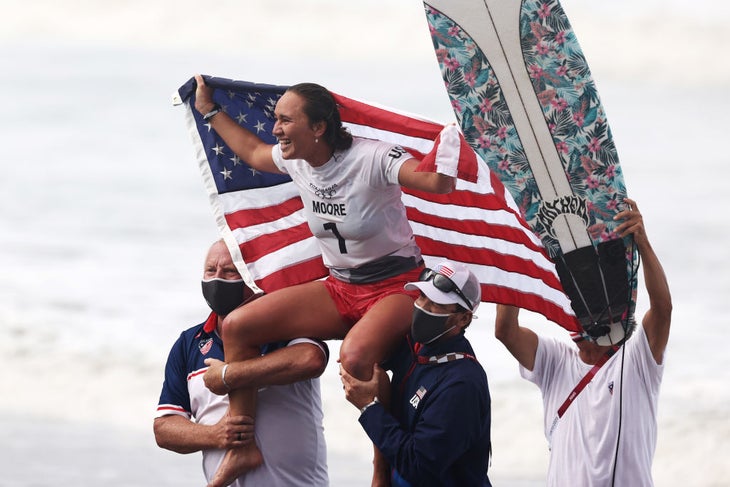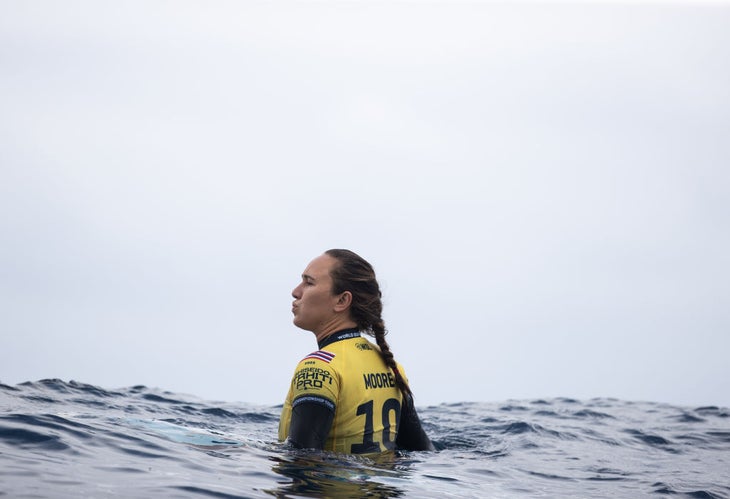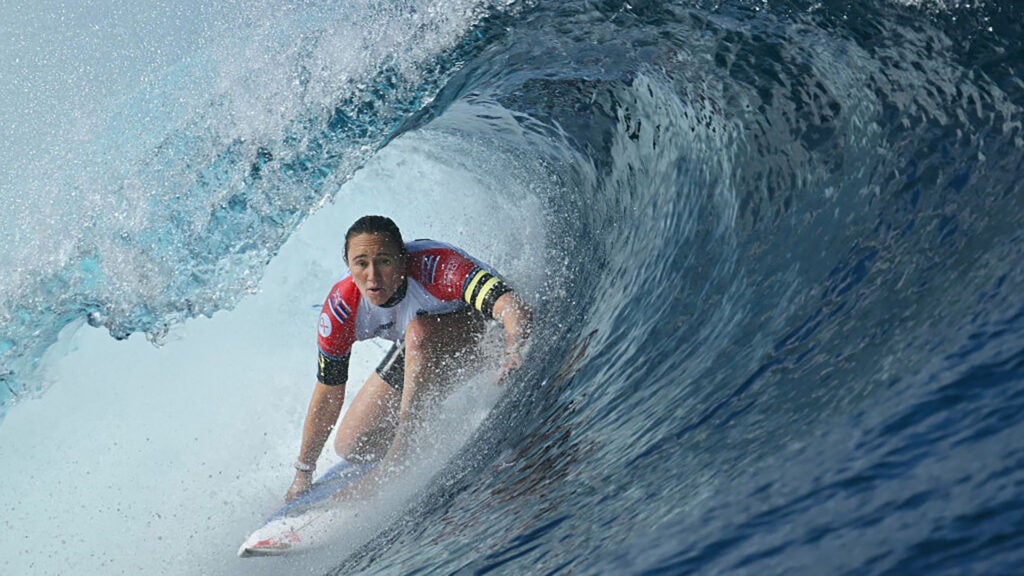No products in the cart.
Outdoor Adventure
Why Carissa Moore Is the Surfer to Watch at the 2024 Olympics
Hawaiian surfer Carissa Moore has long been lauded for her powerful style and relentless desire to push women’s surfing forward. When surfing made its 2021 Olympic debut in Tokyo, Moore also became the first women’s gold medalist. That same year, she went on to win her fifth world championship. The Olympic surfing event begins Saturday, July 27, and the gold medal rounds are slated to be held on Tuesday, July 30.
Moore, 31, will enter the 2024 Summer Olympics as both the defending champ and and a soon-to-be former pro. In January, she revealed her plans to retire following the event. The 2024 surf competition will be at Teahupo’o, Tahiti’s renowned wave that breaks over a jagged reef and is known for its steep, high-speed takeoff, incredible power, and long, deep barrels. Mistakes there can have big consequences: the slightest misstep can mean getting dragged across the reef under an avalanche of crashing water.
The wave was added back to the women’s professional surf tour just three years ago, after a 15-year hiatus, boosting women’s profiles and experience at the treacherous spot. Moore joined the competition there in May at the Shiseido Tahiti Pro, where she finished fifth. Before she returns for her Olympic appearance, Outside caught up with her to hear how she’s training for the big event, which surfers to watch for, and what she’s envisioning for her post-competitive life.
OUTSIDE: How did winning the Olympic gold medal in Tokyo change your life within surfing?
Competing in the Olympics and winning a gold medal opened up surfing to a broader audience, but I still feel like it’s the perfect amount of people knowing me—it’s not too overwhelming and my life hasn’t changed drastically. The coolest thing that’s happened—and wouldn’t have happened if I didn’t win gold—was being painted on the side of a building in Honolulu, my hometown.

It was surfing’s first time in the Olympics. I didn’t really know what to expect. I definitely felt like the scale of media was a lot bigger than competing on the normal surf league tour. People that don’t watch the Championship Tour and maybe don’t understand the sport, understand what the Olympics is and understand the gold medal. So I think being able to relate to people outside of just surfing changed. I definitely met more people from outside the sport that I wouldn’t normally think would ever watch surfing or know who I am. But in that same breath, I don’t know if it’s just the ebb and flow of how media works, but I’m very grateful that it’s not too much.
How does the Olympic surfing competition differ from a normal Championship Tour competition?
Surfing is usually a pretty independent sport. You have your coach or your little crew that travels with you and supports you. But what’s very different at the Olympics is I’m staying with some of the people that I consider my biggest competitors on the championship tour. You know, Caroline Marks, Caity Simmers, John John Florence, and Griffin Colapinto. We’re all staying on the same property and we’re a part of a team and we’re surfing for our country, which is special and different. And as much as it’s competitive, and obviously we all want a medal, it does feel like this is a celebration of our sport and the celebration of sports, and to be a part of that is really cool.

What’s your favorite and least favorite part of the Olympic wave, Teahupo’o?
It’s such a special place in this world. It’s one of the very few places I’ve traveled to that’s fairly untouched, still. It’s nature at its finest, and everything’s raw and big and lush and beautiful. You can really feel the energy and the power of the land and the sea.
That wave, it carries, we call it mana—our power. It really feels like it has a personality and a mood and a mind of its own. It’s a wave that brings out a lot of emotion, it brings out a lot of characteristics in yourself: you have to face yourself at a wave like that, because it takes a lot of confidence, it takes a lot of commitment. It takes facing your fears and facing the things that scare you the most.

People say it’s a beauty and it’s a beast. It’s one of those waves that really deserves time and respect. For it all to come together, you really have to be at peace and in tune with yourself. You can’t hesitate. You have to trust yourself and your ability and your skill set and your preparation, and you have to trust in the wave what it’s going to do. You have to just surrender and let go, which is so much in life. So I’m really looking forward to competing there, as much as I’m scared, and very intimidated, let’s be honest. It’s probably one of the waves that I am fearful of the most and that intimidates me. But I’m looking forward to the challenge.
That was one of the things that played a part in my decision to depart from competing full-time this year; I wanted to spend more time at Tahiti. This is a part of my performance that I wanted to improve, and it’s been really meaningful to me. Just the process of okay, I’m going to put in the time and put all my eggs in one basket, and I’m really going to dedicate myself. Knowing myself and that these kinds of conditions – waves of consequence – is not the strongest point of my game, it definitely changed my approach. I just need to spend the most time as I possibly can there [at Teahupo’o] to wrap my head around it, just spending time in the lineup and with the wave. Surfing the wave and learning the lineup, the different types of waves that come in on the reef.
And then when you’re not there, [it’s about] taking the time to meditate and journal on it and try to visualize myself picking the right wave and problem-solving when it’s time to problem—solve, or, you know, take a couple of deep breaths when that moment of anxiety comes up. But it’s crazy. There’s so many different types of waves. We don’t even know what the conditions are going to look like. There’s so much that’s out of my control. So for me, being open and adaptable to whatever comes my way is a big one, as well.
There’s so much that goes into it besides just surfing and the mental part. I talk to a psychologist, I train a few times a week – there’s a lot of little different pieces of the puzzle. And then it’s just important to have fun and find ways to distract yourself and rest and all that, too.
Which female surfers does Teahupo’o favor?
The women who’ve really stepped it up just in the past few years are so exciting and really inspiring. Brisa Hennessy has had some good showings there the past couple years. Vahine Fierro, she’s a local, and I would say the biggest favorite going into this. Caity Simmers and Caroline Marks, my fellow Americans, are right up there with having a super consistent season already, and both are talented barrel riders. Then you have Molly Picklum, who’s a charger from Australia. I could go on to the whole list of everybody. Obviously, Tatiana Weston-Webb got an incredible wave in this last Tahiti Pro, and she’s a charger as well.

What role do you want surfing to play in your life after you no longer compete?
I’m still figuring that out, and I’m learning that’s OK. Most importantly, I just want my life to be filled with joy, with purpose, and surfing. Surfing will always be part of it, whether that’s in a contest jersey or not in one. But doing things that are meaningful and fill me with joy is what I want to continue to do, whether that’s work with my charitable foundation, or that’s creating performance content pieces that are inspiring other people to chase their passions; if it’s connecting through my social channels to share my story and my experiences and be vulnerable. It’s like “hey, it’s not always perfect.” It always doesn’t look a certain way. There’s no specific timeline or mold or thing that you’re supposed to fit into, and just encourage other people to live authentically and find things that fulfill them

Everyone’s like, how’s retirement? And I’m like, ‘Guys, I’m not retired. I’m just shifting gears and evolving.’ I’m in this transition of change but at the same time, I’ve been busy and had a lot of stuff going on this year, including the Olympics, which is important to me. So post-Olympics, I’m looking to give myself a little bit of time to just settle for a second and then reassess, like, what, where and how do I want to move forward?
My normal, everyday is probably how I will continue to live. I like to get up and go to the beach and go for a surf. I like to work out. I like to work on my Moore Aloha charitable foundation. Even today, in the lead-up to the Olympics, I’m still doing those things. Maybe I’m not preparing for the next event. But I’m still going to be filling my days with going to see my family or taking the dogs for a walk. I don’t know if much is going to change besides the fact that, yeah, maybe there is a little bit of a void that I need to figure out.
This interview was edited for space and clarity.
Source link

